Ethereum Classic Price Analysis - Agartha Hard Fork on January 13th
Ethereum Classic (ETC) is a distributed ledger and decentralized computing platform with smart contract capabilities, created in 2016 by forking the original Ethereum (ETH) project. The crypto asset is currently 20th on the Brave New Coin market cap table, with a market cap of US$591 million and US$242 million in trade volume over the past 24 hours. The ETC/USD spot price is down 90% from the all-time high set in mid-January 2018.
ETC was created after a contentious hard fork, following the Decentralized Autonomous Organization (DAO) hack in June 2016, which lead to approximately US$50 million being drained from the DAO through recursive call attacks. The DAO was originally established as a venture capital fund built on Ethereum and launched with a crowd sale in April 2016. As of May 2016, the fund held ~14% of the Ethereum total supply, roughly ~US$150 million, from 11,000 investors.
To recoup the lost funds, a hard fork of the original Ethereum chain quickly followed the hack. The original chain survived, in large part due to exchange listings, and was renamed Ethereum Classic. ETC proponents questioned the immutability of the ETH ledger after the hard fork solution was implemented. Additionally, the ETC developers and community agreed to cap issuance and decrease the block reward. Annual inflation on the network currently stands at 8.25% (green) compared to ETH’s 4.47% (purple). For ETC, the total block reward is reduced by 20% every five million blocks. The ten millionth block will occur around March 15th, 2020.
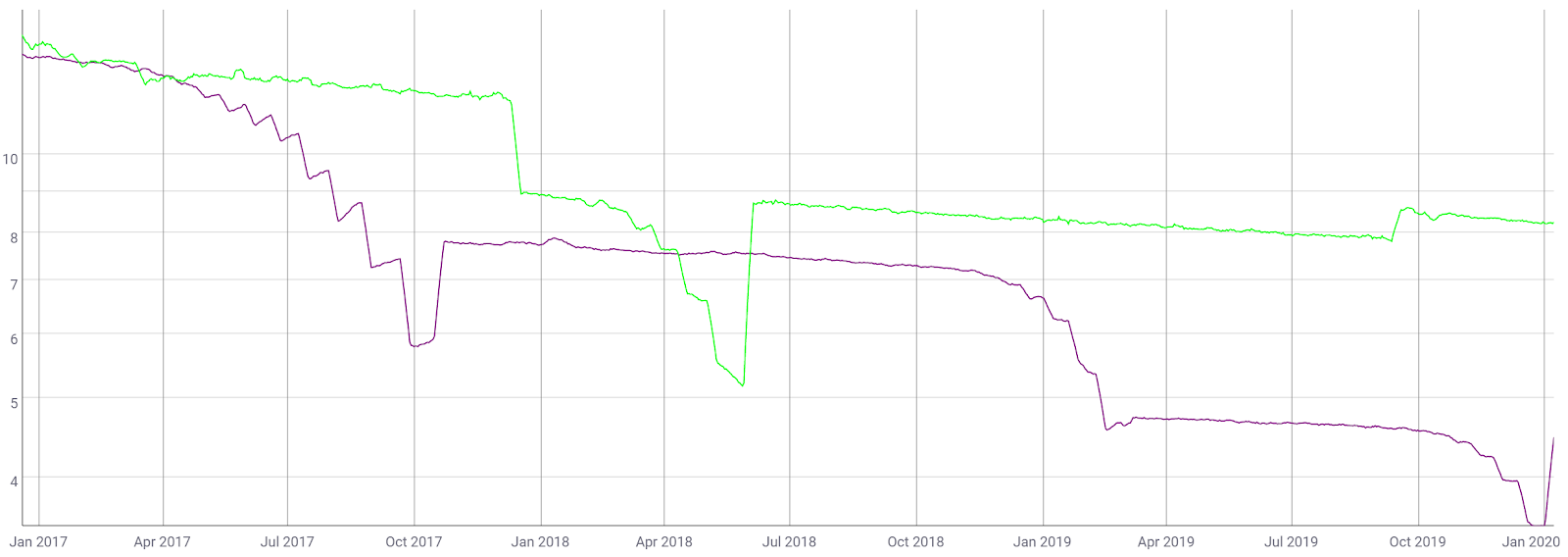
Barry Silbert, the founder and CEO of Digital Currency Group (DCG), was one of the most prominent members of the community to embrace ETC and encouraged future development, through then Hong Kong-based IOHK. In 2019, IOHK announced the company would be moving to the state of Wyoming due to a friendlier regulatory environment.
A subsidiary of DCG, Grayscale, is comprised of several funds that issue shares backed by crypto. The trust that issues shares for an ETC product currently has US$44.1 million in assets under management, representing 9,031,729 ETC, or 7.76% of the circulating supply. Managers of the trust intend to direct up to one-third of the Annual Fee, for the first three years of the trust's operations, towards the Ethereum Classic Cooperative, which has initiatives supporting development, marketing, and community activities.
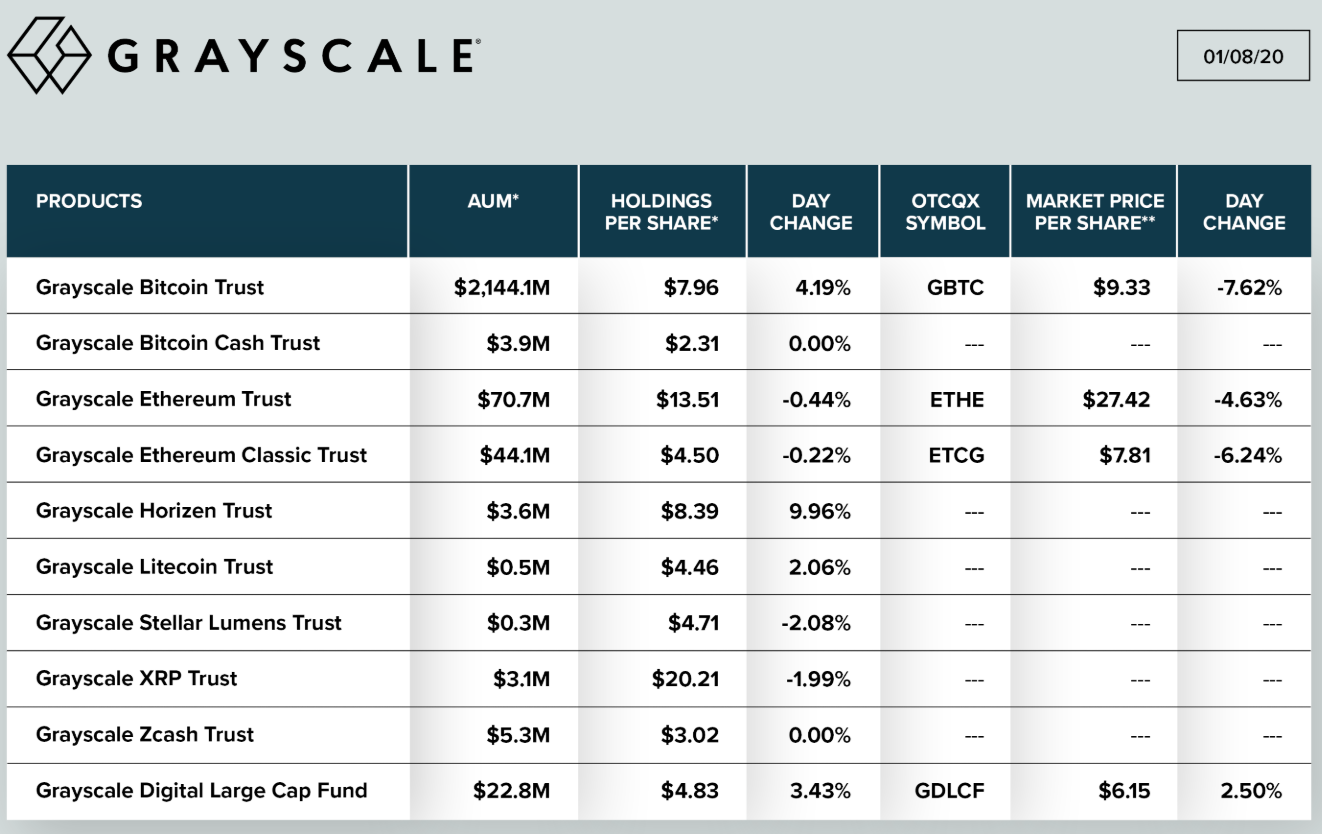
A quick comparison between Ethereum and Ethereum Classic shows Ethereum dominating by all metrics, including market cap, daily transaction volume, daily transactions, daily active addresses, hash rate, nodes, and Github commits on the main repo over the past year.
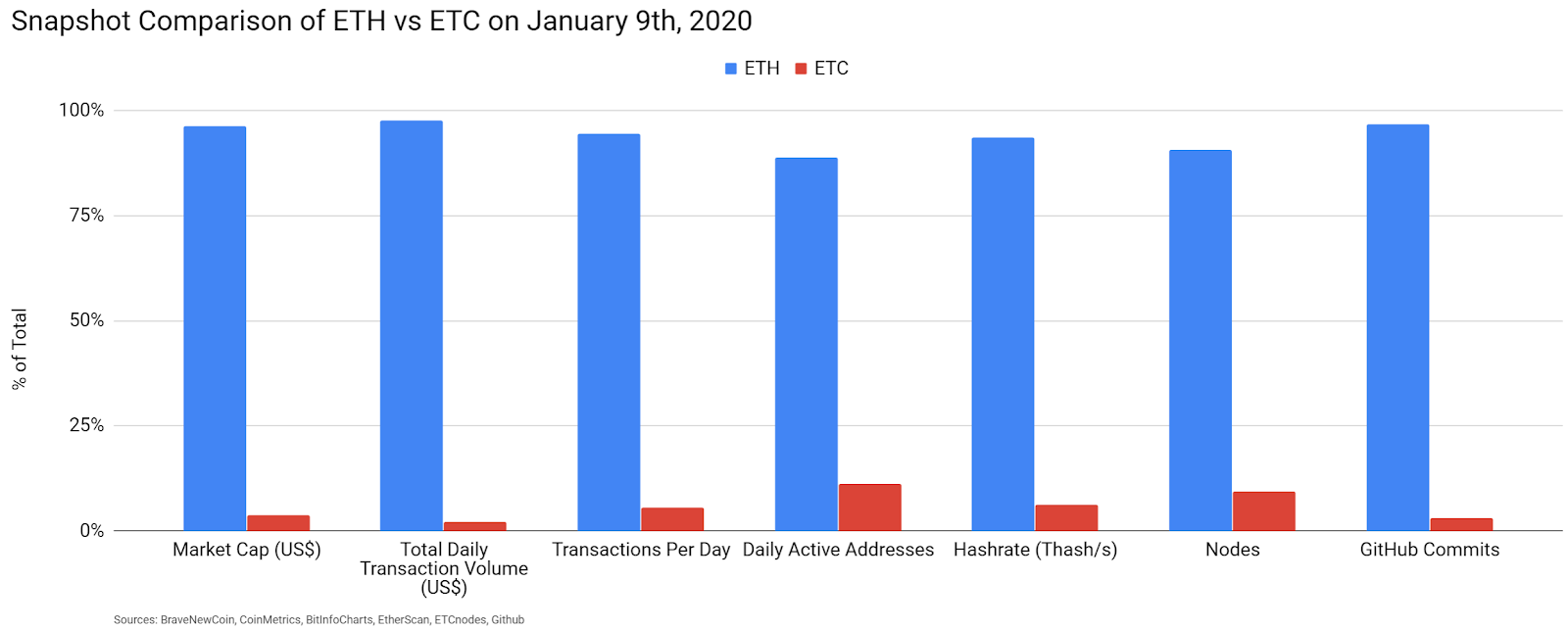
Mining activity over the past few years has increased substantially thanks to ASICs for the Ethash consensus algorithm developed by Innosilicon, Bitmain, and PandMiner. Linzhi, a new Ethash ASIC manufacturer, released its first miner on September 11th.
As Ethereum transitions to a new consensus algorithm, ProgPoW, ASIC miners may migrate en masse to the ETC chain, as they will not be able to profitably mine on the Ethereum chain. Further, the Ethash ASIC manufacturer Linzhi also recently released a new Ethash ASIC. Those who purchased these ASICs will be looking to obtain a return on their investment, regardless of which chain they are mining.

Hash rate peaked in September 2018 and is currently sitting within the previous multi-year range set from October 2017 to July 2018. As opposed to ETH, ETC is unlikely to ever implement Proof of Stake (PoS) and will likely remain a Proof of Work (PoW) chain for the indefinite future. Over the past few months, ETC hash rate has continued to gain ground on the ETH hash rate. However, ETC’s hash rate still only represents 6% of ETH’s hash rate (not shown).

The ETC network has a total of 840 active nodes, most of which are currently running the parity client. The United States, China, and Germany are home to 22%, 14%, and 11% of these nodes, respectively. Nearly 80% of the nodes are running on Cloud networks, such as Amazon, Alibaba, and Google.
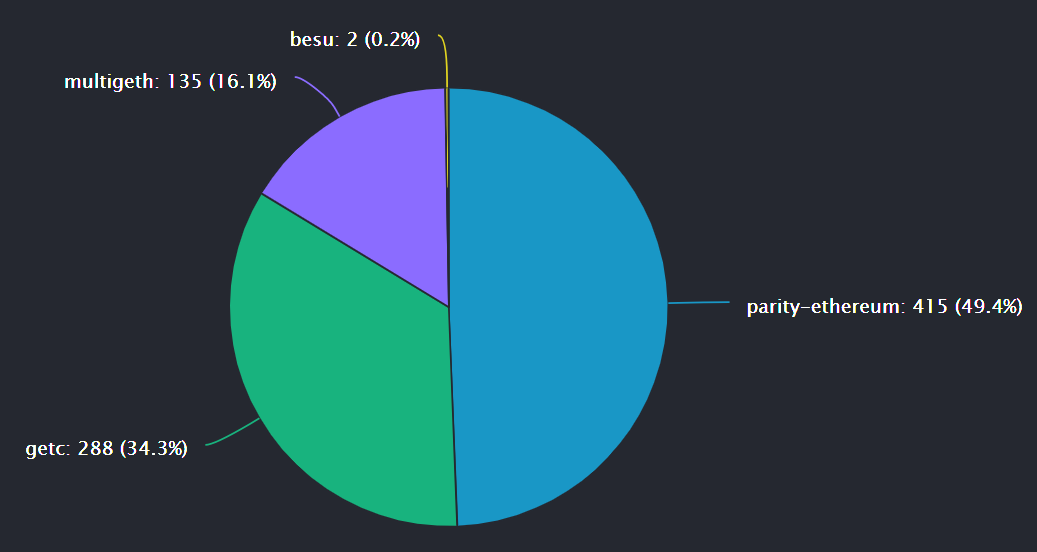
The number of ETC on-chain transactions per day (line, chart below) has ranged from 26,000 to 60,000 since April 2018. Transactions per day hit an all-time high in March 2018 after breaching the 70,000 mark. Any significant uptick in transactions per day should be seen as a bullish indicator. However, the most recent uptick in transactions per day from October to December was not a sustained increase and had no effect on ETC price.
The average transaction value per day (fill, chart below) has decreased dramatically since February 2018 and has ranged between US$100 to US$600 since the beginning of September 2018. The average transaction value hit an all-time high in mid-January 2018, at nearly US$6,000, which corresponded with an all-time high in token pricing. Transaction fees are currently US$0.094, a 12-month high (not shown).
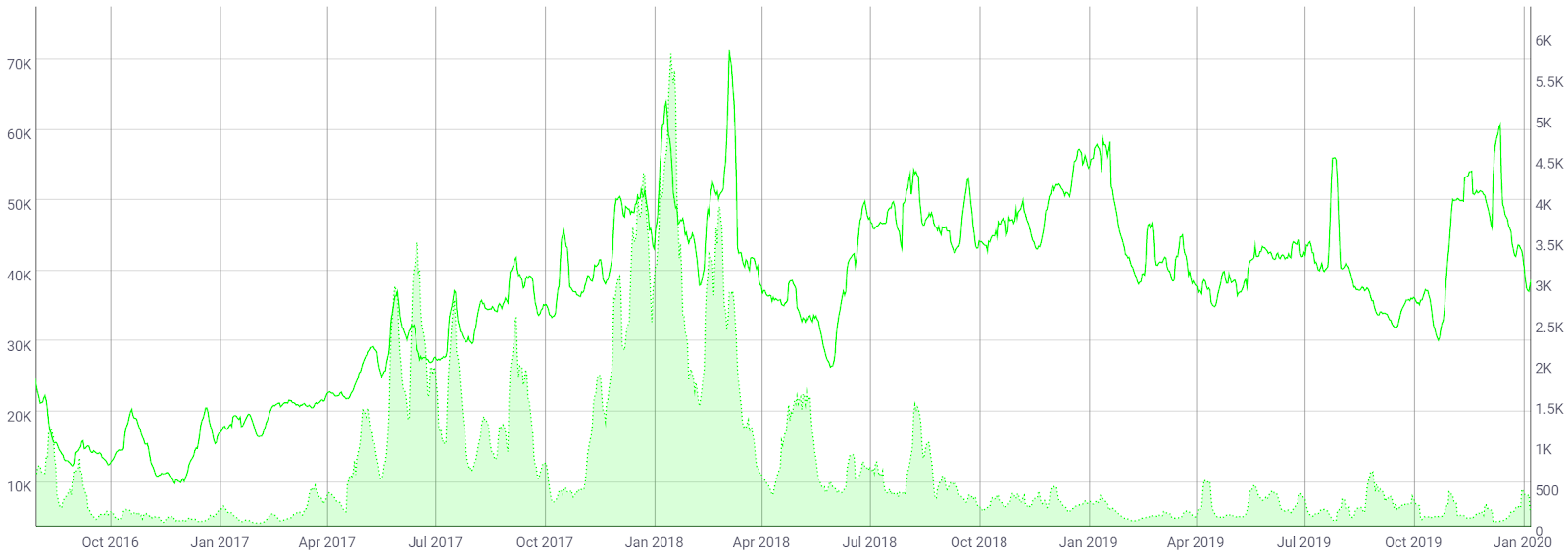
The 30-day Kalichkin network value to estimated on-chain daily transactions (NVT) ratio (line, chart below) increase from 58 to 92 over the past few months, nearing the record high of 120 hit in mid-May. An NVT below 40 is consistent with bull market conditions.
A clear uptrend in NVT suggests a coin is overvalued based on its economic activity and network utility, which should be seen as a bearish price indicator. Additionally, a decreasing NVT in a bear market suggests the asset is currently oversold, or that the NVT metric may need to be retooled to better understand market variables.
Daily active addresses (DAAs) spiked dramatically in late 2018 and held near record levels through most of 2019 (fill, chart below). In October, DAAs spiked to 4.7 million before dropping back to the previous range of 10,000 - 200,000. These addresses may represent a mixing service or a network test. Since October, DAAs have been highly volatile, ranging from 9,000 to 1.1 million. In general, a sustained uptick in DAAs should be seen as a bullish indicator as this indicates increased blockchain use and interest. The inverse suggests declining interest in the chain and ecosystem.

In January 2019, ETC suffered a 51% attack via “deep chain reorganization.” Mark Nesbitt, a security engineer at Coinbase, alerted the community of the attack with a blog post explaining the matter. Coinbase disabled ETC transfers at the time, and subsequently re-enabled them on March 11th. The trading platform now requires 5676 confirmations for ETC deposits, which would take about 24 hours in normal conditions.
The attack resulted in double-spends for 219,500 ETC, which was around ~US$1.1 million, according to the blog post. Shortly after the attack, a site designed to monitor the status of any potential 51% attack was released by ETC Labs. Hashrate has remained relatively stable since the incident.
Exchanges are typically the most vulnerable and biggest targets during a 51% attack. Gate.io reported the theft of 40,000 ETC, which was around ~US$200,000. A few days later, US$100,000 in ETC was returned to the exchange with no explanation. Bittrue announced that there was an attempt to withdraw 13,000 ETC during the 51% attack, but the withdrawal was stopped by exchange-side countermeasures.
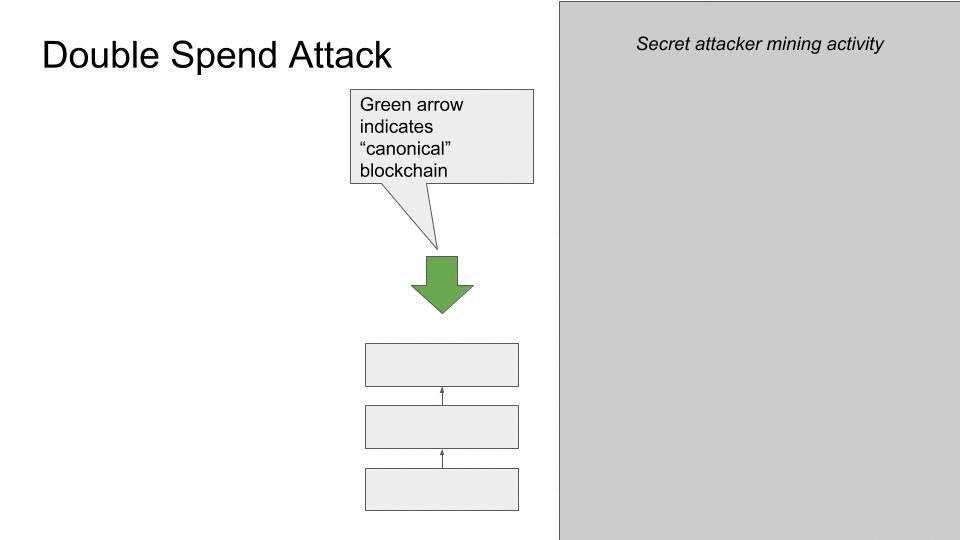
Turning to developer activity, the ETC project on Github is split between “ethereumclassic” and “etclabscore.” ETC Labs Core rebranded to ETC Core in December, to avoid confusion with ETC Labs. Most coins use this development platform, where files are saved in folders called "repositories," or "repos," and changes to these files are recorded with "commits," which save a record of what changes were made, when, and by who. Although commits represent quantity and not necessarily quality, a higher number of commits can signify higher dev activity and interest.
The most historically active repos have had relatively few commits over the past year (shown below). The Ethereum Classic Improvement Protocol (ECIP) repos have been the most active over the past few months.
After the 51% attack in January 2019, ECIP-1049 was introduced by Alexander Tsankov. The proposal centers on changing the ETC PoW algorithm from Ethash to Keccak256. Tsankov believes that this algorithm would be less vulnerable to 51% attacks. Keccak256 is also used for ETH smart contracts. Discussions regarding the possible change are currently ongoing, and include a wider discussion around implementing ProgPoW, which is likely to be released on ETH later this year.
In April, the ETC Labs dev team released ECIP-1054, Atlantis, which enabled the Spurious Dragon and Byzantium network protocol upgrades currently active on the ETH network. The protocol changes increased interoperability between the ETC and ETH chains. Atlantis was successfully implemented on the main-net on September 12th. The _Constantinople _protocol changes will be included in _Agharta_, ECIP-1056, set for launch on block 9,573,000, or approximately January 13th. Both ECIPs occur via a hard fork and both aim to increase ETC and ETH compatibility.




In the markets, ETC exchange-traded volume over the past 24 hours has predominantly been led by the Tether (USDT), Bitcoin (BTC), and Ethereum (ETH) pairs. The Korean Won (KRW) pair currently holds no premium over the USD pair.
Although many exchanges paused ETC deposits and withdrawals in January 2019, during the 51% attack, trading has since resumed. In April, Poloniex enabled ETC/BTC margin trading up to 2.5x leverage for non-U.S. customers. ETC/BTC and ETC/USD pairs were added to ETHfinex in May. The recently launched Binance.US enabled ETC/USDT and ETC/USD trading pairs in September. Binance.com delisted the ETC/USDC and ETC/TUSD pairs in November and December, respectively, and OKEx listed an ETC/USDT pair in December.
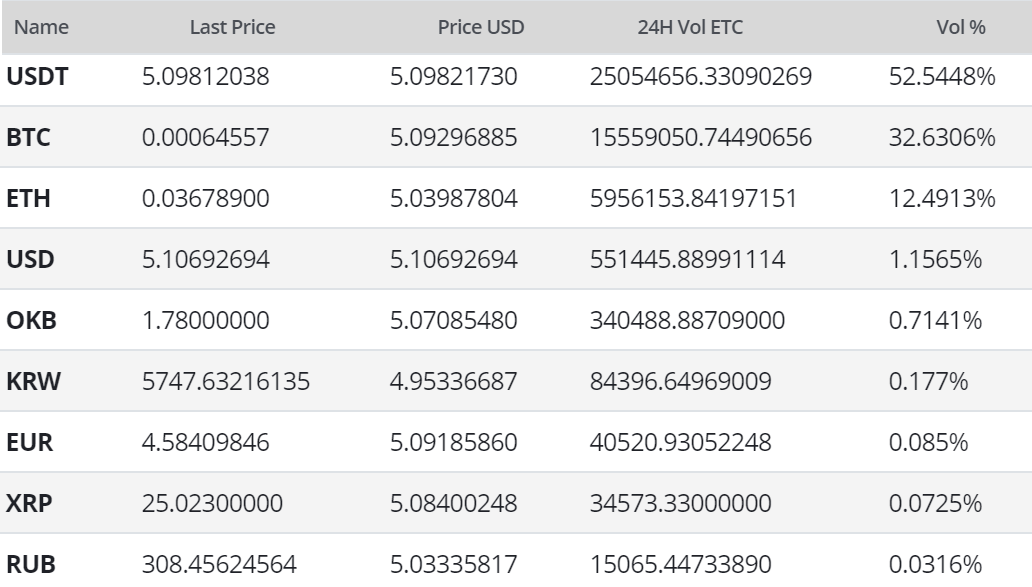
Technical Analysis
The 51% attack in January 2019 seems to have had no long term impact on ETC price. Since the December 2018 lows, ETC has essentially moved in line with the broader crypto market. Potential roadmaps for upcoming price movements can be found on high timeframes using Exponential Moving Averages, volume profiles, Pitchforks, chart patterns, and Ichimoku Cloud. Further background information on the technical analysis discussed below can be found here.
On the daily chart for the ETC/USD market, the 50-day and 200-day exponential moving averages (EMAs) have been bearishly crossed since July 24th. The 200-day EMA at US$5.25 should now act as resistance but a bullish 50-day and 200-day EMA cross may occur over the next few weeks. Significant volume support (horizontal bars) sits at the current local low of US$4.30. There are currently no active Relative Strength Index (RSI) or volume divergences.
The long/short open interest on Bitfinex (top panel, chart below) since April 2018 has been heavily net long, with long positions currently accounting for 90% of open interest. A significant price movement downwards will result in an exaggerated move further, as the long positions will begin to unwind. This is known as a “long squeeze.”
Price also remains bound by a multi-year bearish Pitchfork (PF) with anchor points in May and September 2017, and May 2018. Price broke out from a falling wedge in November 2018, to the downside, breaching the PF median line (yellow) with significant bearish momentum. Price has now re-tested the median line several times, confirming a support level. Based on this PF, the macro trend will remain bearish until a break above US$7.70. The US$9.65 zone and US$10 level will then represent significant psychological resistance.
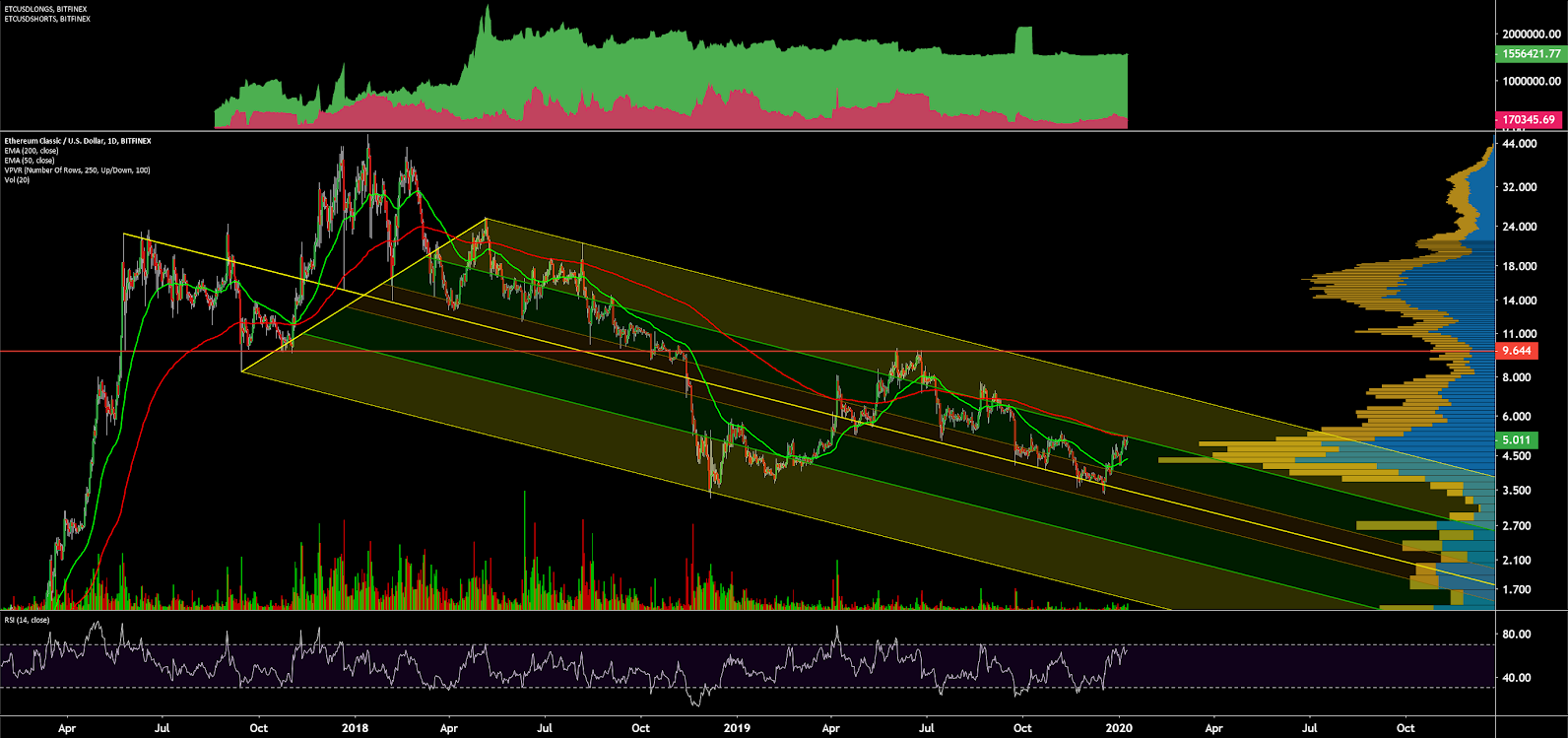
Turning to the Ichimoku Cloud, four metrics are used to indicate if a trend exists; the current price in relation to the Cloud, the color of the Cloud (red for bearish, green for bullish), the Tenkan (T) and Kijun (K) cross, and the Lagging Span. The best entry always occurs when most of the signals flip from bearish to bullish, or vice versa.
Cloud metrics on the daily time frame, with doubled settings (20/60/120/30) for more accurate signals, is neutral to bullish; price is inside the Cloud, the Cloud is bearish, the TK cross is bullish, and the Lagging Span is below Cloud and above Price. A long entry will not trigger until the spot price is again above the Cloud, which may occur in the next few weeks.
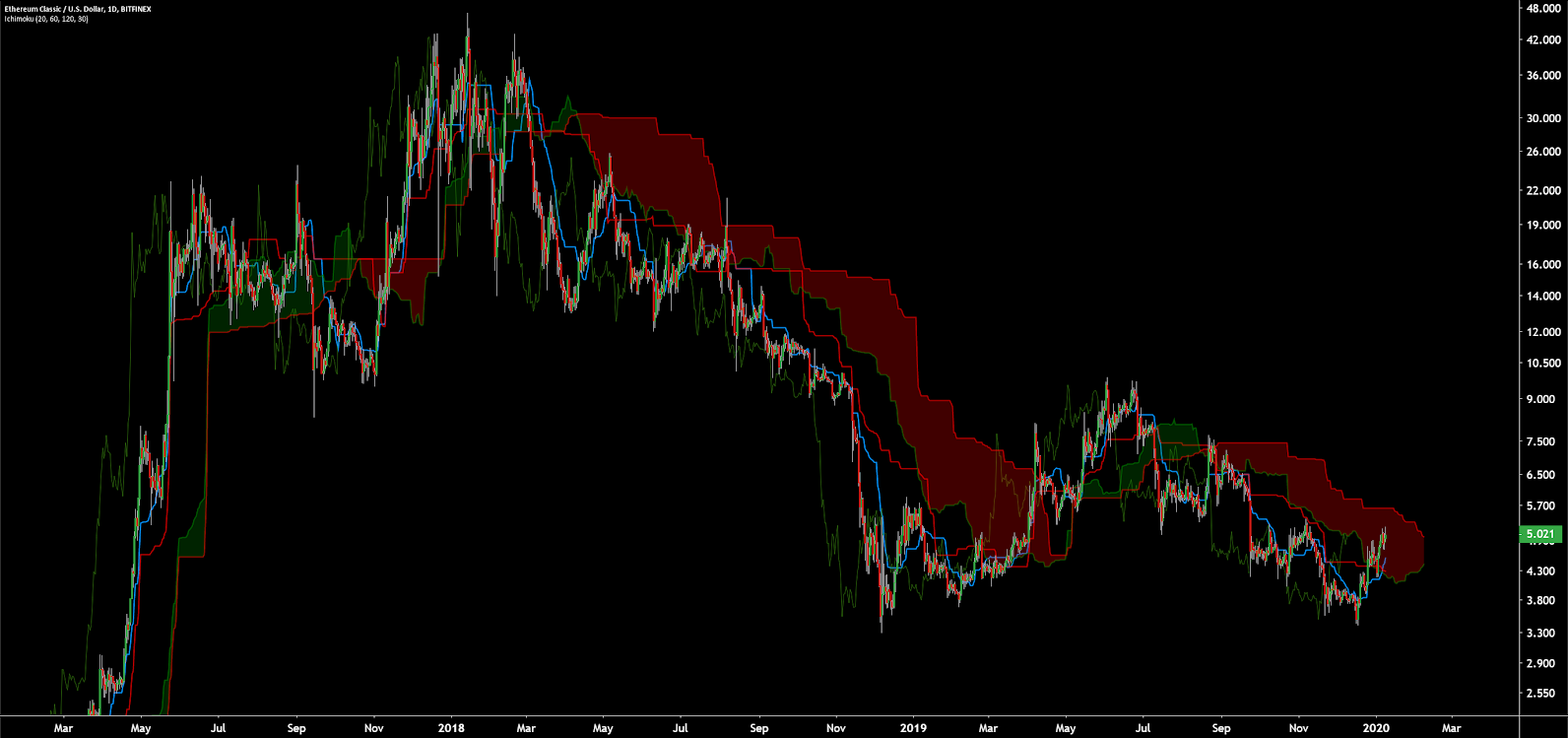
Lastly, on the daily ETC/BTC chart, trend indicators suggest a nascent bullish trend as potential Golden Cross may occur in the next few weeks. Additionally, Cloud metrics have begun to flip 100% bullish. The 50-day and 200-day EMAs have been bearishly crossed for over 650 days. Based on the historic volume profile, the spot price is unlikely to break above the 0.00115 BTC zone any time in the near future. Open interest on Bitfinex is currently 74% short (not shown).
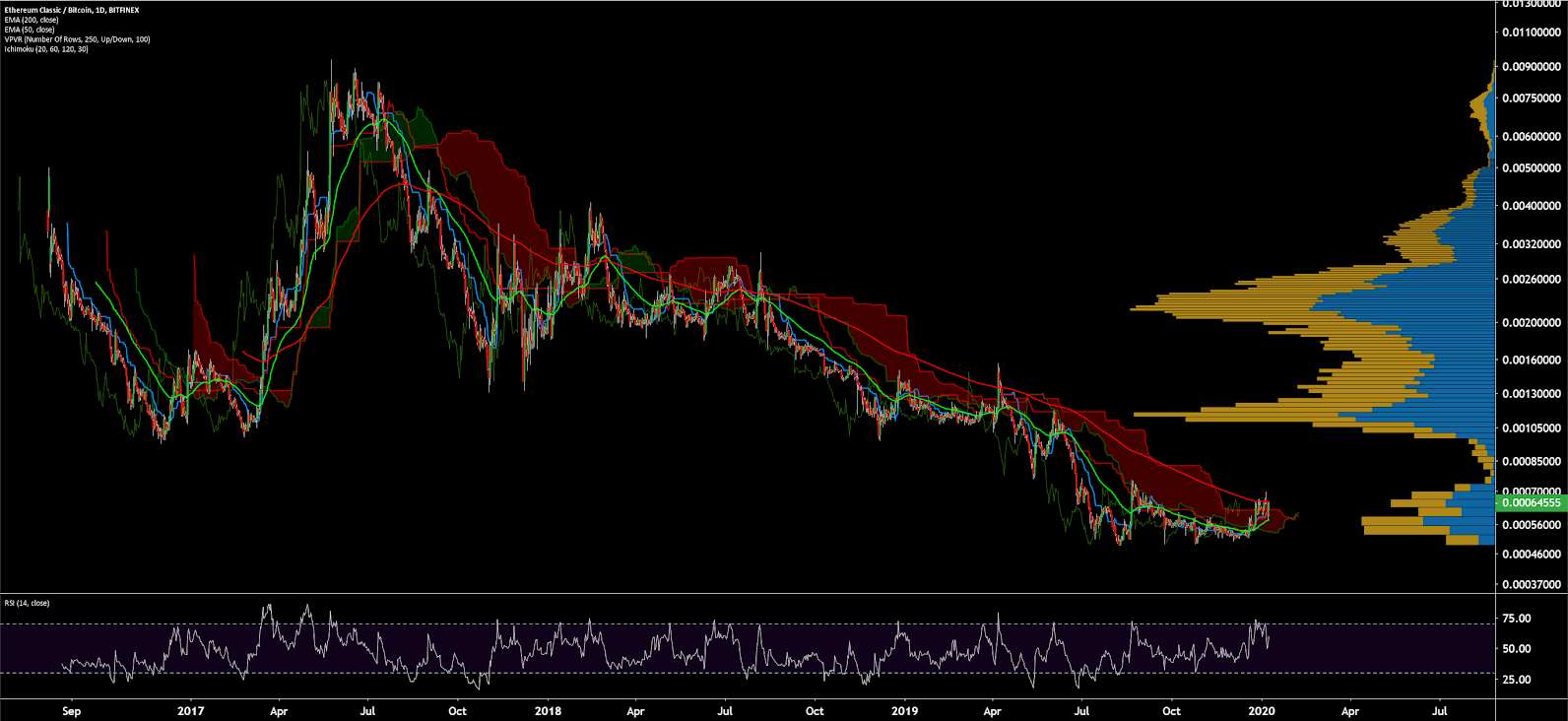
Conclusion
Ethereum Classic (ETC) continues to play catch-up with Ethereum (ETH) development, after implementing Atlantis in April 2019, and Agartha set to mainnet release on January 13th. The ETC chain also has relatively little Github dev activity over the past six months.
Also in stark contrast to ETH, ETC’s value-add appears to be a hard cap on the total number of coins, and there are no plans to change from PoW to PoS. ETC’s block reward is also set to be reduced by 20% around mid-March this year. ETC may rise to prominence in the mining world after the ETH consensus algorithm change to ProgPoW, as ASIC miners will look to turn a profit. There is a pending proposal to change the consensus algorithm in an attempt to increase ASIC resistance.
Technicals for both the ETC/USD and ETC/BTC pairs suggest an early bullish trend. At the very least, trend metrics are neutral with the likelihood of a bullish rally over the next few weeks. Upside targets for both pairs are US$7.50-US$7.70 and the 0.0011 BTC range. ETC/USD prices above the psychological resistance of US$10 should see significant bullish momentum. Speculators opposed to the ETH ProgPoW and Proof of Stake changes may also look to hedge on ETC in the near future.
OhNoCrypto
via https://www.ohnocrypto.com
Josh Olszewicz, Khareem Sudlow
